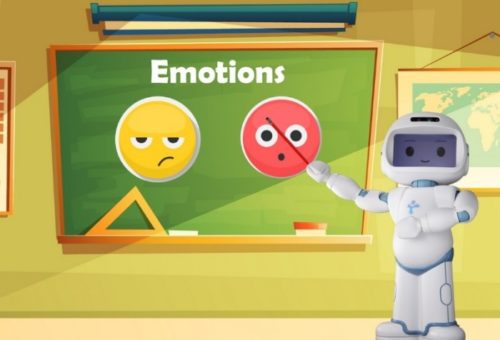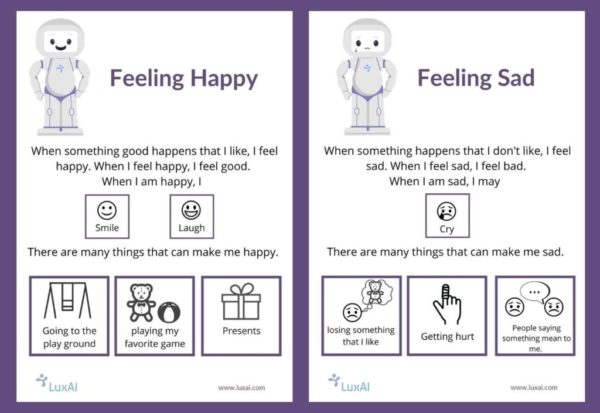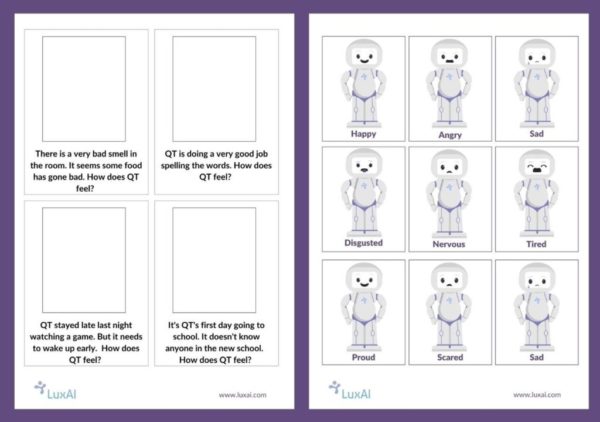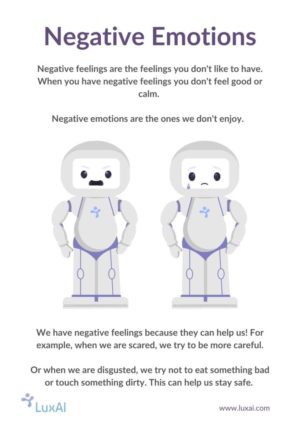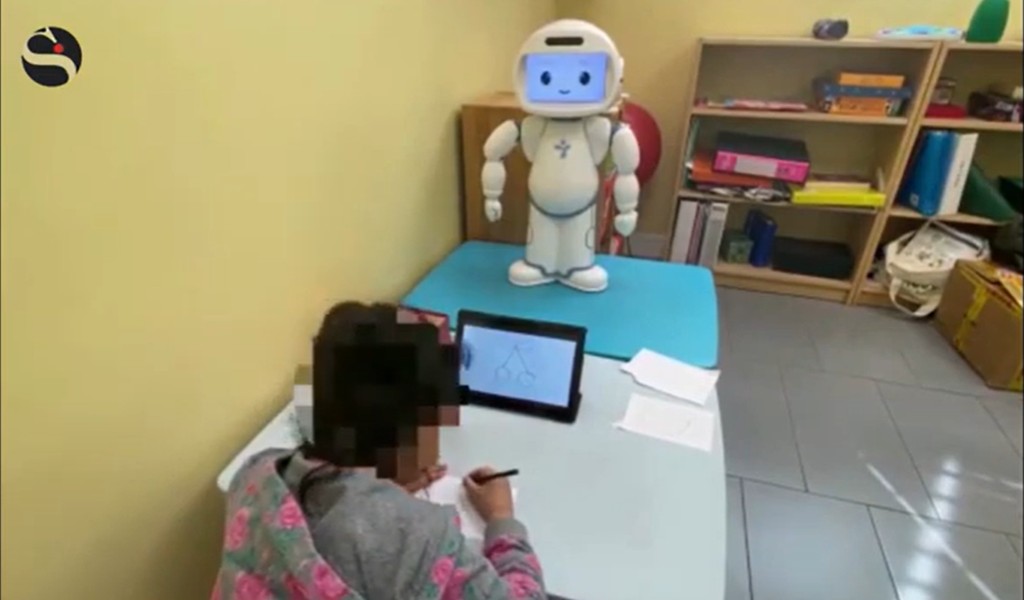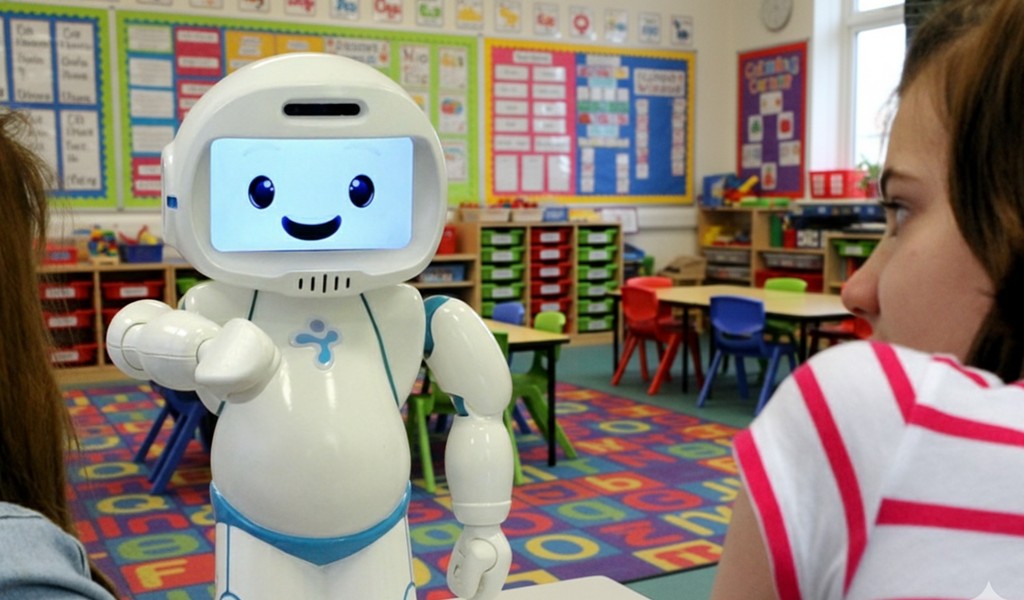Children with autism often have difficulty in understanding the emotional status of others and often structured activities for teaching emotion understanding is very important. Not being able to understand emotions and not being able to react to emotions in others and in themselves, is one of the main causes of distress for people with autism. This difficulty can lead to internalizing mental health problems including depression and anxiety as well as externalizing mental health problems like aggressive behaviors and meltdowns.
Scientific studies show that teaching emotion recognition and understanding in a structured way can improve emotional skills for children with autism and empower them to have a better understanding of emotions. It can also have a positive direct impact on their mental health and wellbeing.
For example, one study using QTrobot to deliver emotional ability trainings has shown to improve the mental health of children with autism within 7 one-hour weekly sessions.
In this blog we discuss simple step by step activities that can help parents and educators of children with autism to enhance emotion understanding in children with autism:
6 step by step activities for teaching emotion understanding to children with autism:
Some tips before starting to practice emotion understanding:
- Emotions are abstract and difficult to teach since they have a broad range and often people are feeling a mix of emotions at the time. So it is important to be patient and help a child with autism gradually, consistently and age-appropriately.
- Every time a child is able to identify a trigger for emotions, understand emotions or respond appropriately to them, it is important that we give them lots of praise and reinforcement, so they can clearly understand that they have done a good job.
- If the child is not able to understand or respond to emotions appropriately, we need to give them clear prompts and cues. Prompts can help children to learn without many lots of trial and error and they are very effective for teaching any new skill.
- We want children to learn functional skills that they can use every day, so when helping them to learn emotion understanding, it is important to use any possibility to point out triggers and their emotional outcome. During the day, when we are at home, or out in the playground and in the city, there are many opportunities to point out emotions in other people and discuss why someone is feeling them. Practising emotion understanding in the natural environment is the best way to make sure the skill becomes generalized and functional for children.

1. Use social stories to help children grasp the meaning of emotions and how they are felt:
Social stories are great tools for teaching social and emotional skills to children with autism and neurodevelopmental disorders. They focus on a very specific topic, explain it with simple and short sentences and they include simple visuals to help the child to learn more easily. Social stories are great for introducing emotions in a very simple way and help children to learn when and how each emotion is felt. They are also great tools for teaching children with autism about reacting to emotions in themselves and in others.
Below is a free social story series you can use to help children with autism to better understand emotions and how they are triggered:
2. Use kid’s stories and books to teach emotion understanding:
Reading story books, particularly those with pictures, is a useful tool to teach children with autism to learn about emotions, their triggers and their behavioral outcomes. When reading a story to your child, you can simply point out different characters and explain a bit about how they feel and ask questions about their emotions from your child. This is a great way to help them learn about the emotion triggers and help them to learn about the situations that can cause a specific emotional outcome.
3. Use activity cards for teaching emotions:
One of the best ways to help children understand emotions and their triggers is to play card games and guessing games that are focused on emotions. For example, you can show your child a card displaying a simple situation and then ask your child to guess the emotion that is triggered by this situation. It is best to try situations that are more relevant to your child and can discuss something that is probable for your child to experience in their day-to-day life. In this way children can already know about how they might feel in various situations and this will be great when we want to help them to learn coping and emotion regulation skills.
Below is an example of situation cards you can download and practice with your child at home:
4. Help your child to categorize emotions:
Emotions and wellbeing are a complex topic for many people and can be doubly so for children and young people with autism. Emotions, changes in internal states, and the events that cause these are not always clear and well defined.
Helping your child to categorize and group emotions and triggers can help them to understand their feelings better, and to decide how to respond to each emotion. There are many resources that can help children put emotions in to groups and also assign colors to each group. In this way we can help them to learn how to react to each group of emotions rather than each individual emotion.
One of the good tools to use for teaching emotion categorization is an emotion wheel. In the emotion wheel the emotions are often categorized in 4 categories with 4 specific colors. Then each group is broken down into several specific emotions colored with a specific color from the same category. This can help children to learn that several emotions are expressed and felt similarly, and they can be responded to in a similar manner.
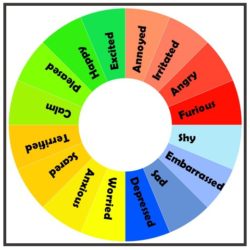
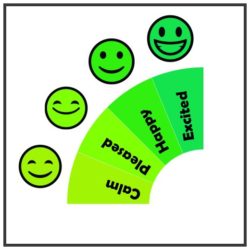
Emotion wheel and color coded emotions for helping children with autism to categorize emotions
5. Play sorting activities with children about emotions:
One of the good activities that can help children to put emotions in context is play sorting games. We can ask children to sort emotion in two categories: Positive emotions and negative emotions. It means we have emotions that we like and enjoy, and we want to experience them more often. The emotions like happiness, excitement or being proud will go to this category. And then, we have emotions that we don’t like to have and are negative, like being sad, embarrassed or being angry. This activity is great because not only it helps in emotion understanding, but it is a great start for moving forward to teaching emotion regulation and calming down strategies. When children know which emotions are negative, then we can help them learn how to manage these emotions and how to use various strategies to cope with them.
6. Play activities and games that practice emotion intensity:
After teaching your child to categorize emotions to positive and negative ones, it is good to help them to learn about emotions that are too intense. This activity is very important because in the next step, we want to help children to be able to control and regulate their intense emotions. For example, it is ok for everyone to feel angry, however, we don’t want children to remain angry for a long time or engage in unsafe behaviours when they are experiencing intense anger.
To help children to understand what it means to have intense and too strong emotions, we can again use some activity cards that are sharing a situation that has happened, but they also include the response of the person in the situation. Then you can ask your child about if the response and the behavior was correct and wrong and the person in the situation is experiencing a normal or too strong emotions. For this activity we can also use visual cards, similar to the ones below to help the child to choose either normal or too strong emotions.

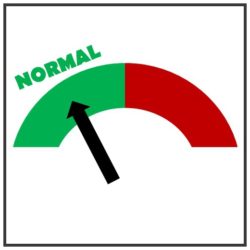
Visual cards for helping children to label emotions as normal and too strong for practising emotion understanding
This activity can be a good generalization practice for the previous ones too. For example, you can read the scenario and then first ask your child about how the person is feeling in the situation and then continue reading the person’s response to the feeling and ask if the response was good or it was too strong.
Using a social robot for teaching emotion understanding to children with autism:
Social robots are assistive technologies that can facilitate teaching activities that are related to emotional abilities and social skills. There are many research projects that demonstrate that using a social robot can improve the outcome of emotional trainings in children with autism. By being constant, predictable and attractive for kids, children with autism tend to have higher focus and better collaboration in emotion related activities comparing to the times that they are doing the same activity with an adult alone. Also, it has been shown that children tend to have a longer duration of attention when they are working with a social robot than the time they are practicing with a human caregiver. This can be because of the non-overstimulating and non-judgmental behaviors of a robot.
QTrobot, emotion tutor for children with autism:
QTrobot is an educational robot designed for children with autism and it comes with a comprehensive educational curriculum that is focused on emotions. In this curriculum, QTrobot practices a variety of emotional skills in a step by step and age-appropriate manner, helping children to practice emotions in various type of scenarios and situations.
A scientific study using QTrobot for emotional ability training shows that only after 7 sessions of emotion related games with the robot, children had better emotional appropriateness as well as reduced anxiety and depression that are cause by their emotional difficulties. Also, the emotion related autism symptomatology was reduced in the participants of the training.
Interested to know more about QTrobot curriculum for emotional skills? Check out the outline of the activities and the topics covered by each unit from the link below:
